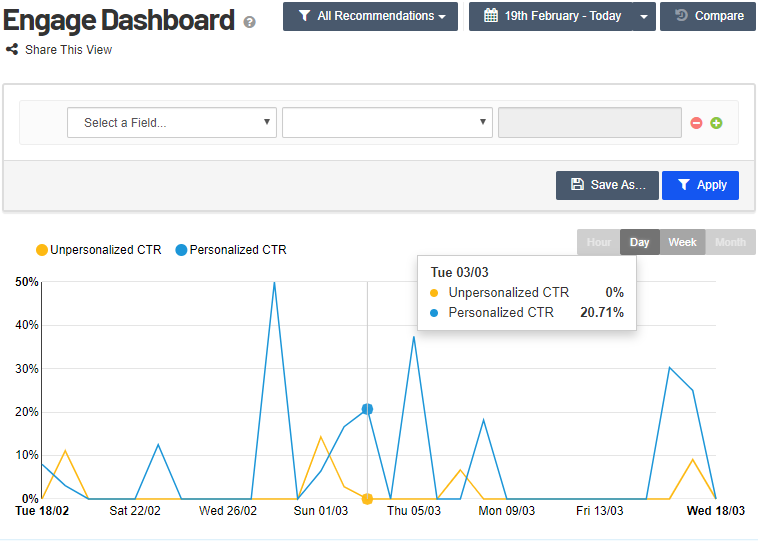 Providing content recommendations
Providing content recommendations
Content Recommendations delivers personalized content recommendations in real time to visitors of your website. The recommendations are delivered by a widget for which you can set up individual rules – flows – for excluding and including content.
This user scenario provides an example on how to work with Content Recommendations. For installation and configuration instructions, see Content Recommendations on Optimizely World.
In this user scenario, you
- use the Content List to review the ingested content items and test filters
- create flows and apply them to a section
- apply the section to a delivery widget
- analyze recommendations
Filtering content
In this scenario, your developer has just implemented Content Recommendations on your website (the source) and Content Recommendations ingestedThe process of gathering topics for analysis. For example, if a new URL is added to your website where Content Recommendations is implemented, that content is ingested into the system. If content changes after it was ingested, you can reprocess the content. all content itemsContent Recommendations: A web page that has an identifier associated with it.. Use the Content List to get an overview of the ingested content items.
- In the upper menu bar, click Content > Content list.
- In the filter area, select Source is at least one of {your source's name}. Click Apply.
- At the bottom of the content area, below the list of content items, the total number of content items from the selected source is displayed. In the example, Content Recommendations ingested a total of 17844 pages from the website.
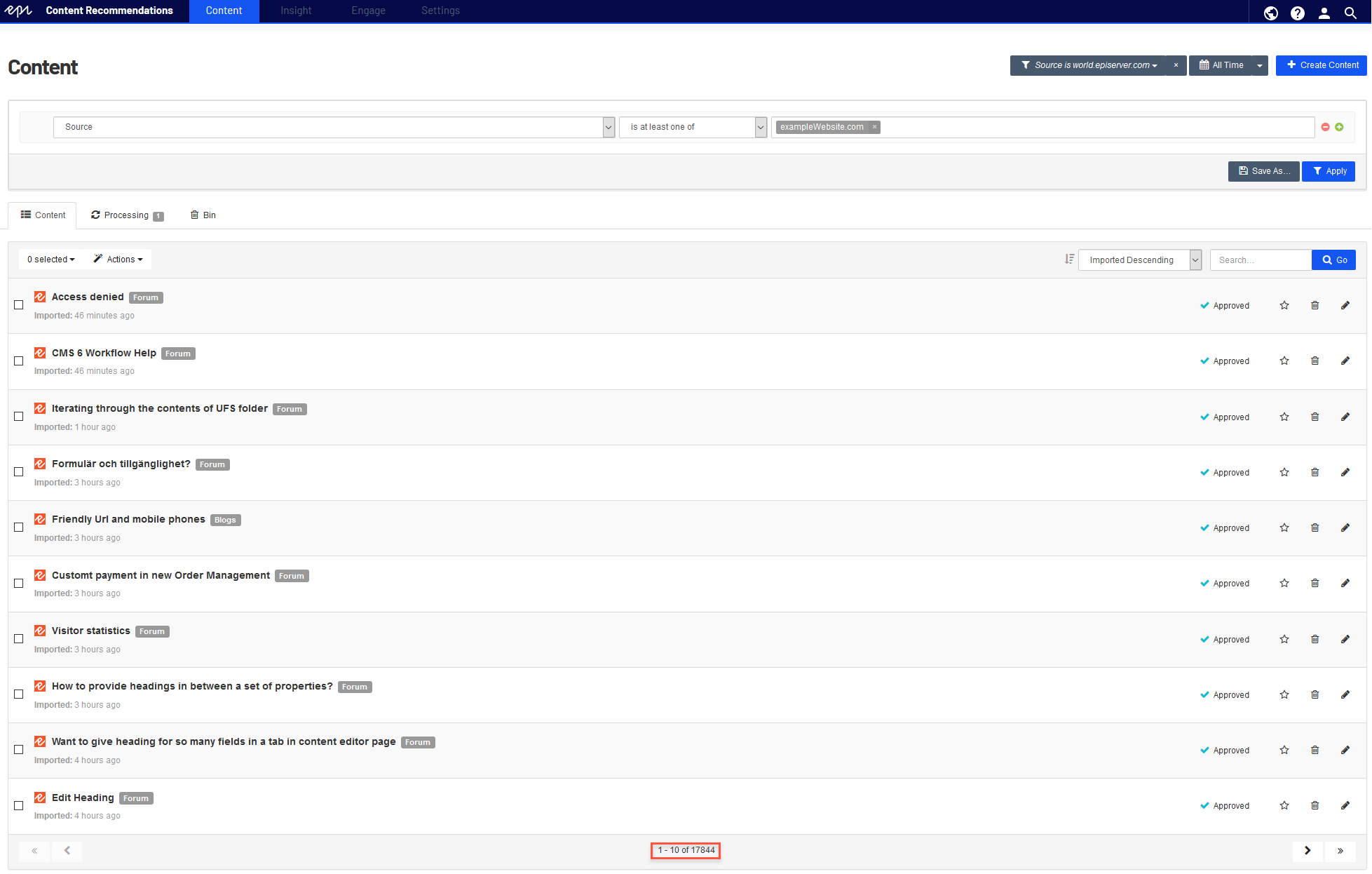
- Click a content item for more details, for example the topics that Content Recommendations extracted using NLPNatural language processing. A subfield of linguistics, computer science, information engineering, and artificial intelligence concerned with the interactions between computers and human (natural) languages, in particular how to program computers to process and analyze large amounts of natural language data. - Source: Wikipedia. For more information, see Content List.
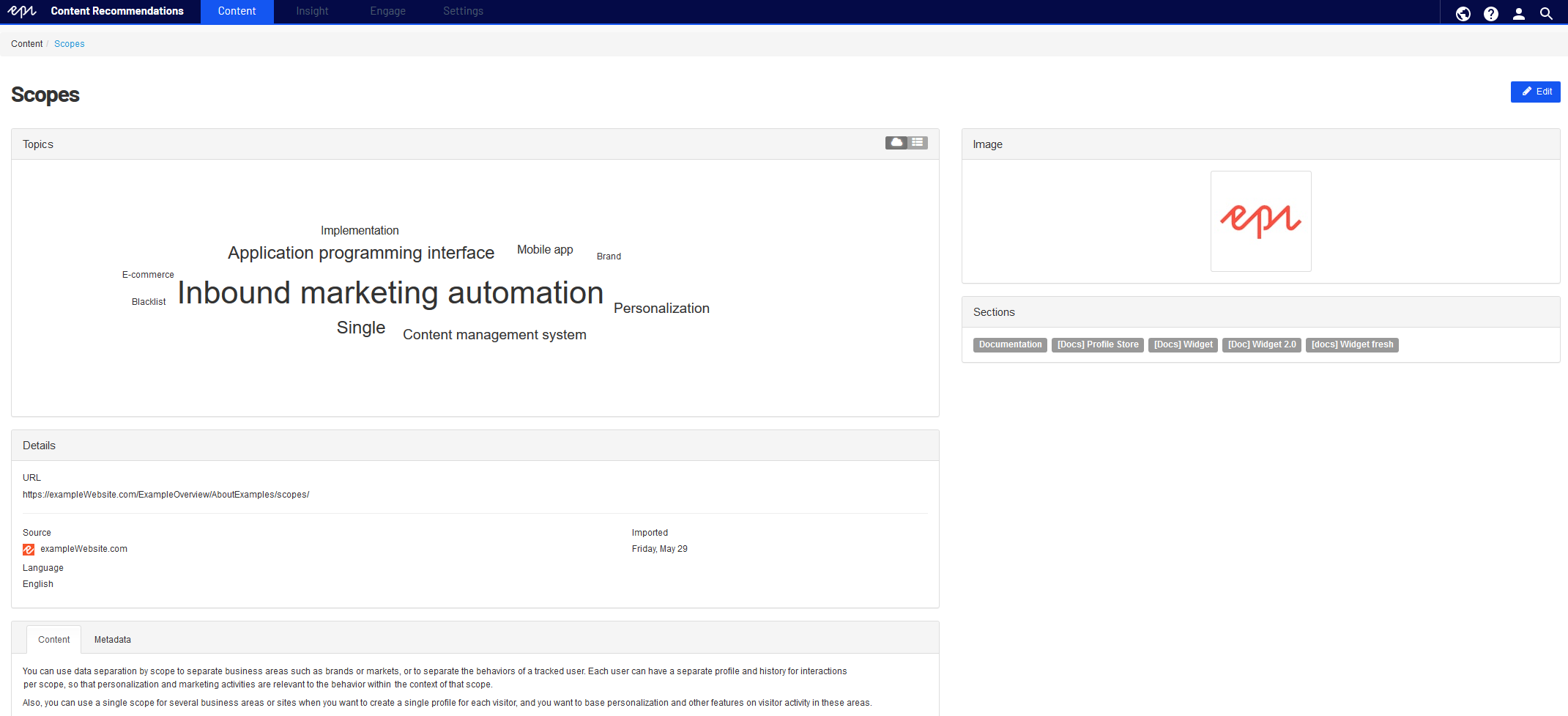
- Return to the Content List view and create filters to include or exclude content, for example content from the editorial section of your website without archived and outdated pages (in the example, content under /archived and /items). See how the total amount and origin of the content items change according to the set up filters.
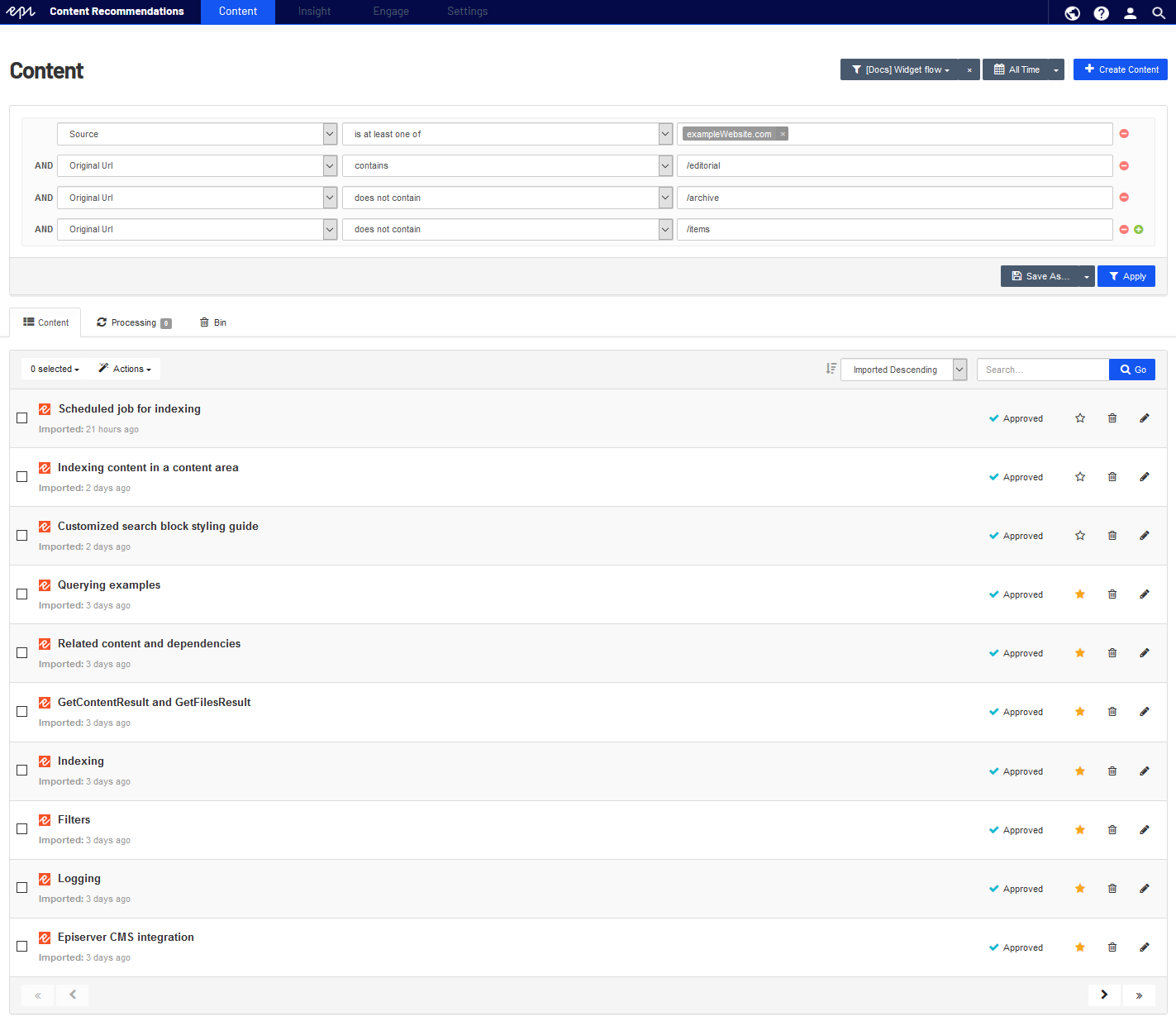
To check the amount of content items filtered by a filter setting that excludes content, flip the condition from does not contain to contains. Example: Original URL does not contain /archive shows a total amount of 16078 items. When flipping to Original URL contains /archive the total amount changes to 134 items. So there are 134 items under /archive on the website.
- If you want to reuse this filter setting in the future, save the filter settings by clicking Save As.... If the filter setting may be useful for your colleagues, activate the Share this filter with other members of my organisation check box.
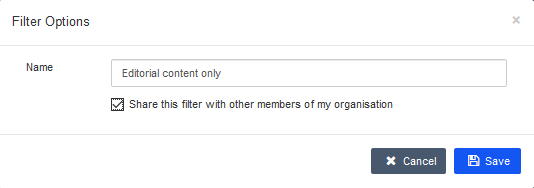
Saved Content List filters cannot be used in the Flows view. To recreate a complex filter created under Content List in the Flows view, you can take a screenshot (under Windows: Windows key + Shift + S) of the filter.
Creating Flows
Flows are rules that define which content is used for recommendations. You may want to recommend only dedicated content of your website, or exclude archived or outdated pages.
You can create multiple flows and group them in a section. The section is then applied to the delivery widget that delivers the recommendations to your website:
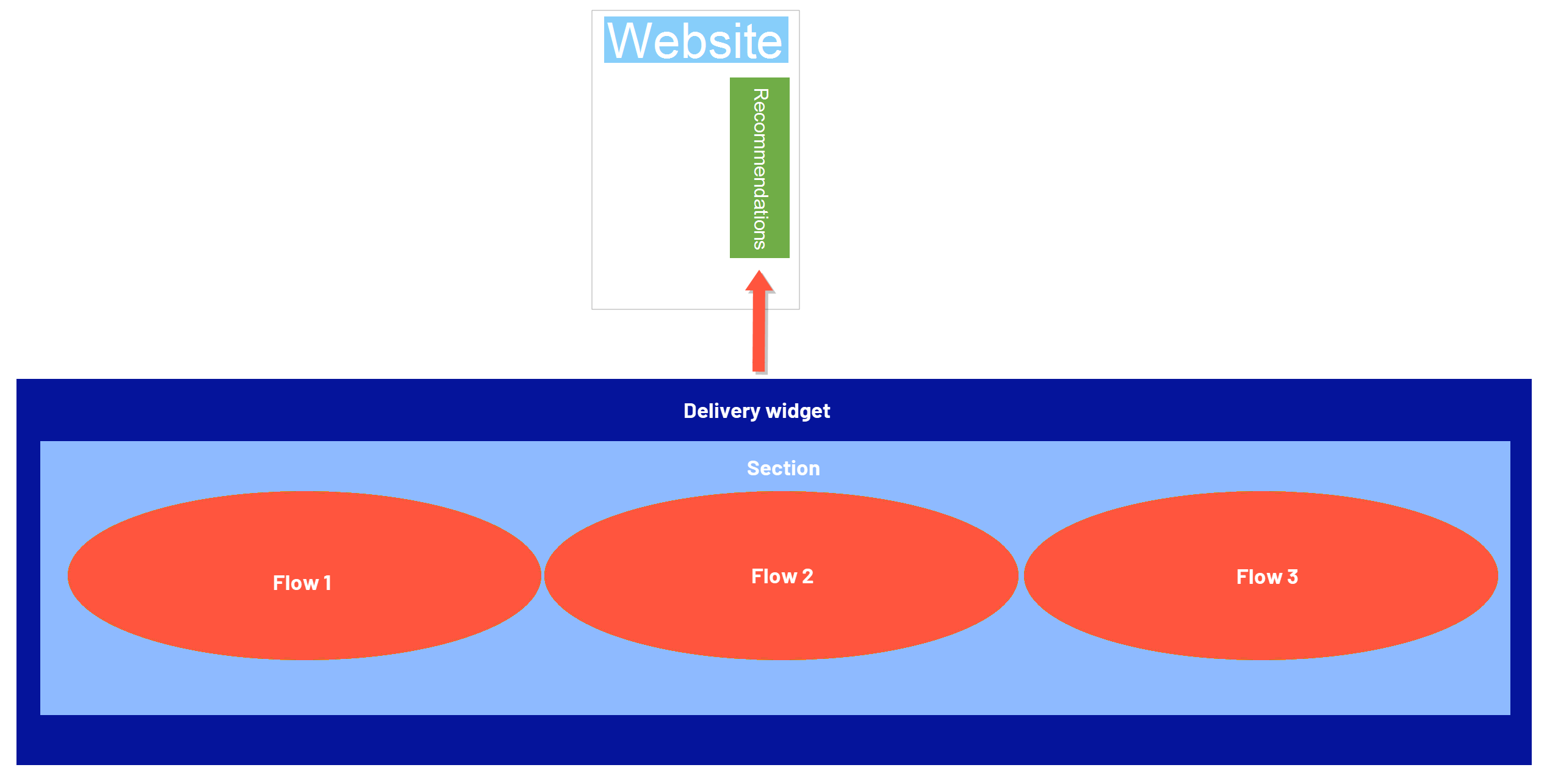
To create a flow, add filters from widest-to-narrowest until the preferred range of content is covered. Flows follow a clear structure and do not allow nesting. Therefore you have to create multiple flows for different tasks and bundle them in a section.
Example: To deliver recommendations from the blogs, articles and tips pages of your website, you have to create three flows, each filtering content items from www.exampleWebsite.com/blogs, www.exampleWebsite.com/articles or www.exampleWebsite.com/blogs. Then, to make use of all three flows, apply them to a sectionContent recommendations: Groups of content based on flow rules. For example, a Europe section may include blog posts about London, Amsterdam, or Paris; while an Asia section may include blog posts about Shanghai, Hong Kong, or Tokyo..
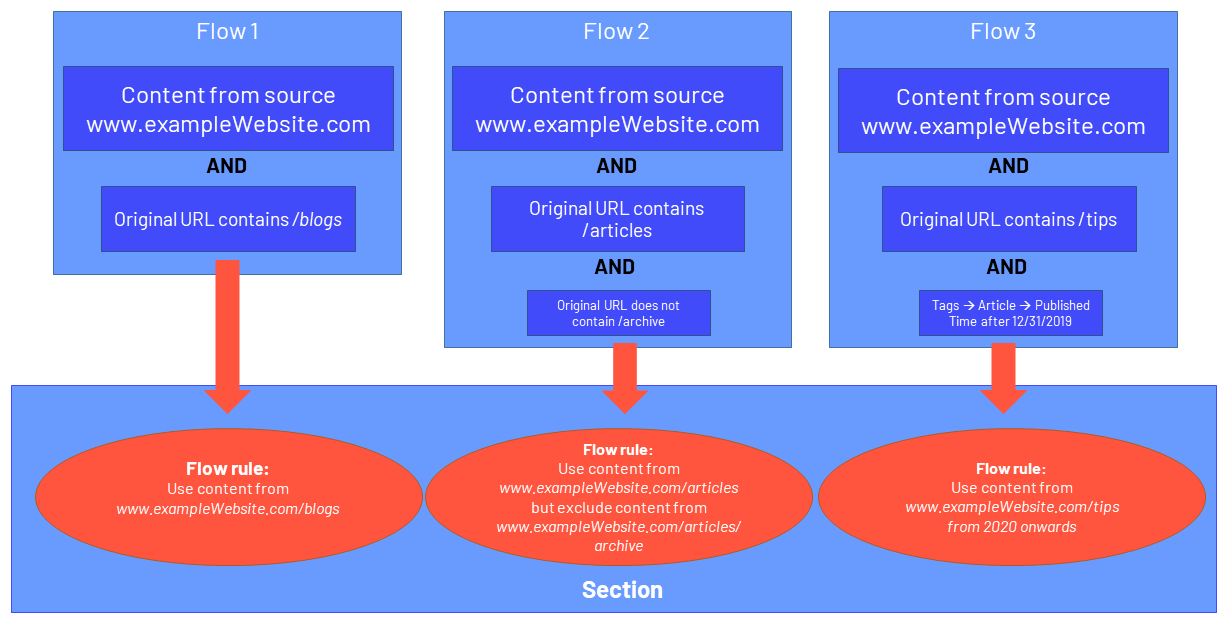
To create Flow 2 from the example above, follow these steps:
- Click Content > Flows in the upper menu bar.
- Click the Create Flow button.
- In the filter area, select Source is at least one of {your source's name}.
- Add a filter by clicking the + icon.
- Select Original URL contains /articles.
- Under Options, the total amount of content items diminished to 1500 items.

Click Preview to see 10 sample items.
- Optional: As 1500 items appear to be too much, you can investigate the filtering by using the Content List. Save the flow by entering a Flow title and clicking Save. Then, go to Content > Content List and set up the same flow as you did in the Flows view. For tips on how to analyze content items, see the Filtering content chapter. When you finished the analysis, return to the Flows view and select the flow you were working on.
- The content under www.exampleWebsite.com/articles/archive contains historical pages that are kept for completeness and should not be part of recommendations. To exclude this content, click the + icon and select Original URL does not contain /archive.
- Check the Options area. In the below image, the total amount diminished to 821 items which seems to be appropriate.
- In the ... take these actions area, click Approve to give the filtered content approval status.
If you select the Move to bin check box, the affected content will automatically be moved to the trash can when it is re-ingested. These contents are then no longer available for flows or analyses. Instead of excluding the /archive area of the website by a flow in the example, you can alternatively create a flow that automatically moves all content elements from this area to the trash can.
- Under Add to Sections, enter a name for a section. Content Recommendations will automatically create a new section with this name. Assign all further flows to this section. If you already created a section, click into the field and select a section from the drop-down list.
- Click save.

- Follow step 2-12 to create more flows that refine the content in your newly created section.
Applying a section to a delivery widget
Your developer implemented a widget on your website that is to show content recommendations to visitors. For information on how to install and configure Content Recommendations, see Content Recommendations on Optimizely World.
If everything is set up properly, you can apply the newly created section to the delivery widget.
- Go to Engage > Deliveries.
The menu item Deliveries requires extended user rights. Contact your Content Recommendations administrator.
- Select the delivery widget that is to deliver the content recommendations on your website.
- In the Edit Delivery view, drag the section that groups your flows onto the Personalized Content area.
The Personalized Content area is for flows and sections that define content recommendations for website visitors whose data you have already collected. If you drag sections onto the Unpersonalized Content area, content recommendations are shown to users who visit the website the first time.
- As the flows in the section approve the filtered content automatically, select approved content under Approval state.
- Click Save.
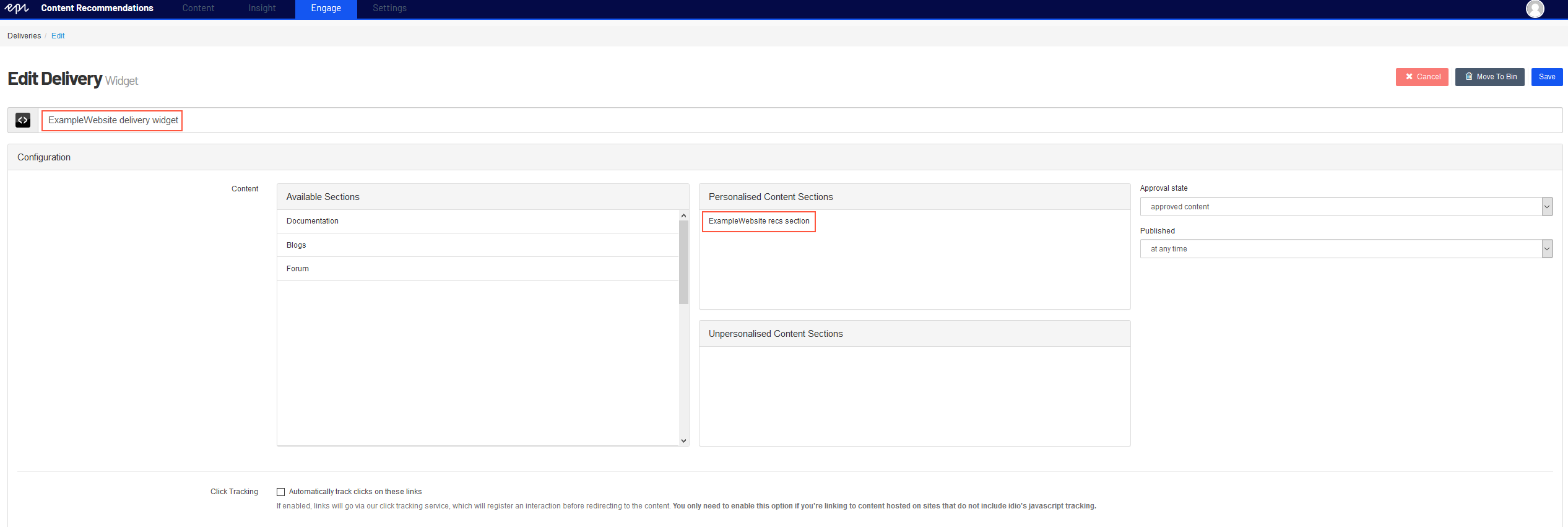
- If the widget is already in place on your website, go to your website and check if recommendations are displayed.
Analyzing recommendations
Use the Engage Dashboard to see the performance of deliveriesDeliveries include retargeting, blocks on a web page, and personalized email that contains relevant content that is based on previous interactions and interests. in a specific time period. You can compare personalized content recommendations with unpersonalized content recommendations that are shown to users who visit the website the first time.
